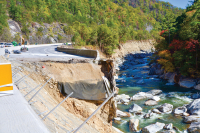Charlie’s Bunion and early history of the park
(Editor’s note: This column first appeared in The Smoky Mountain News in July 2005.)
Are you by chance looking for a high-elevation day-hike that embodies quite a bit of the region’s human history? If so, try the moderate to steep portion of the Appalachian Trail that leads from the Newfound Gap parking area in the Great Smoky Mountains National Park to Charlies Bunion.
Murlless and Stallings in Hiker’s Guide to the Smokies (1973) designated Charlies Bunion to be “probably the most spectacular view in the park. Almost sheer cliffs drop more than 1,000 ft. into Greenbriar section.” Located on the Tennessee-North Carolina border 4.0 miles north of Newfound Gap, this bare rock outcrop is situated at 5,375 feet. The narrow, cliff-hugging trail affords breathtaking views not only down into the abyss but far westward out beyond Mt. Le Conte into Tennessee. It’s not the Grand Canyon by any means, but the site can give you a touch of vertigo in a heartbeat.
The rocky outcrops of Charlie’s Bunion (formerly called Fodderstack) were created in the mid-1920s when a fire swept over the crest. The exposed humus was washed completely away shortly thereafter in a deluge. The curious place name dates to 1929 when Swain County native Charlie Conner was hiking with outdoorsman Horace Kephart, photographer George Masa, and others along the high divide. When they paused for a rest on the rocks, Conner took his boots and socks off, exposing a bunion or two that rivaled the surrounding stones. Eying Conner’s feet, Kephart remarked, “Charlie, I’m going to get this place put on a government map for you.” And he did.
As exciting as the views from Charlie’s Bunion are, the walk from Newfound Gap up over Mt. Kephart and down around Masa Knob is equally interesting. It’s a stroll through the early history of the Great Smoky Mountains National Park.
Newfound Gap (5,040 feet)is situated 16 miles from the Oconaluftee Visitor Center on the North Carolina side of the GSMNP. The site came by its name when it was discovered (perhaps as early as the 1850s) by surveyors to be a lower pass through the high Smokies than Indian Gap two miles to the west. In 1928, when funds to acquire national park lands were proving hard to come by, John D. Rockefeller donated over $5 million as a memorial to his mother. In 1940, President Franklin D. Roosevelt (1882-1945) dedicated the GSMNP — which had been officially founded in 1934 — in ceremonies at the gap.
Related Items
At 1.7 miles, the AT leads to a gap and an intersection with Sweat Heifer Creek Trail. According to Allen R. Coggins in Place Names of the Smokies (1999), this name “goes back to a time when cattle (including young, virgin female cows called heifers) were driven up the strenuous pathway along this stream to summer pasture.” One supposes that this sort of rugged terrain made the virgin heifers sweat.
At 2.7 miles, the AT reaches the intersection with the Boulevard Trail, which leads 5.3 miles to Mt. Le Conte, named for John Le Conte, a scientist, not for his older brother, Joseph Le Conte, as is often supposed.
About 100 yards from the AT, a spur trail off the Boulevard Trail leads 0.8 miles to Mt. Kephart (6,217 feet) and the Jump-Off (6,100 feet), which also has truly spectacular views. The mountain is named for Bryson City writer Horace Kephart (1862-1931), author of the classics Camping and Woodcraft (1906) and Our Southern Highlanders (1913). Kephart was a force in the movement that helped establish the GSMNP and was nominated to have a mountain named after him in the late 1920s while still living.
This story is told in full for the first time in a Web site titled “Horace Kephart: Revealing an Enigma” www.library.wcu.edu/digitalcoll/kephart/), which was completed about six years ago by the Special Collections division of Hunter Library at Western Carolina University. Using a variety of media, the library has built an in-depth archive around the life and times of Kephart that presents photos, artifacts, documents, writing, maps, and links to other sources of information.
In the section of this Web site devoted to the naming of Mt. Kephart, it’s noted that, “The life of Horace Kephart ended unexpectedly in a 1931 automobile accident. While the National Park he campaigned to create was not yet a reality, it was already clear that despite the obstacles to its founding, the park would come to the mountains he had grown to love. Of the many individuals involved in creating the park, Kephart was already recognized as a leader in the movement during his later years …The North Carolina Literary and Historical Commission urged that a mountain in the coming park be named after Kephart. In 1928 [a peak] in the proposed park was officially named [for him], an honor rarely given to living individuals.
At 2.9 miles along the AT you will reach Icewater Spring and shelter (5,900 feet) after swinging around the North Carolina side of Mt. Kephart. From Icewater Springs, the trail drops down through slate outcrops and across Masa Knob.
George Masa (1881-1933) was the well-known Japanese photographer whose Japanese name was Masahara Iisuka. Masa had a commercial studio in Asheville, but he spent as much time in the Smokies with his dearest friend (who he called “Kep”) as he could. His magnificent photographs of the Smokies often illustrated the articles Kephart wrote in support of the park movement. Masa was so distraught when Kephart was killed in the automobile accident that he petitioned the government with a barrage of letters requesting that he be buried with “Kep” at a site in the Smokies. This was not to be. Masa is buried in Asheville.
But it is absolutely appropriate that their names be linked in this way via natural monuments in the high Smokies along that portion of the AT leading from Newfound Gap to Charlies Bunion.
George Ellison wrote the biographical introductions for the reissues of two Appalachian classics: Horace Kephart’s Our Southern Highlanders and James Mooney’s History, Myths, and Sacred Formulas of the Cherokees. In June 2005, a selection of his Back Then columns was published by The History Press in Charleston as Mountain Passages: Natural and Cultural History of Western North Carolina and the Great Smoky Mountains. Readers can contact him at P.O. Box 1262, Bryson City, N.C., 28713, or at This email address is being protected from spambots. You need JavaScript enabled to view it..









